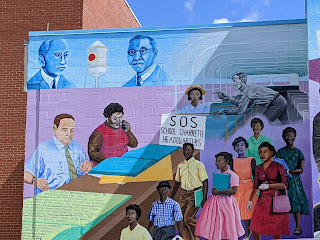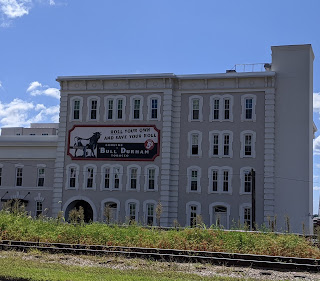Unfortunately, Steven and I had neglected to check the opening hours of several tourist sites we'd hoped to see in both Durham and Chapel Hill, North Carolina, on a Sunday morning back in September last year. I know you'd think that, as seasoned travelers, we'd have done our homework and known what would be open what day and plan our days accordingly, huh?! To our chagrin, we discovered that several were closed and therefore ended up at Olmstead State Park instead. We had to keep our eyes peeled on the ground and not trip over all the exposed tree roots.
This Daily Travelogue is a labor of love for our families and friends at home and around the world. Prior to 2020, all our trips were documented on separate, yearly blogs which can be accessed below. Remember that clicking on any picture will open it for better viewing. Also, please consider adding your name at the end of any comments. Be safe, stay healthy, and stay connected.
Saturday, June 5, 2021
9/20/20: Durham & Chapel Hill, NC: Parks, Murals, & Universities
It was frustrating and sad that virtually nobody was wearing a mask that day. We couldn't remember the last time we'd been on such a popular trail as this one when we couldn't even walk ten minutes without coming across people. It was a pleasant hike but not quiet or serene with so many people and animals on the trail. I guess other people may have thought the same about our being on the trail at the same time as they were, though!
As gorgeous as the majestic trees were, our stroll was marred somewhat by the thunderous roar of planes flying low overhead as we were on the flight path for the Raleigh Durham airport.
I would guess that in non-Covid times the boathouse on Big Lake still would have been open even this late in the season. It looked rather forlorn, in my opinion. The lake was the biggest of three man-made lakes in the picturesque park.
I wondered why there were so many rocks in just this one spot in the park and nowhere else - quite strange.
I wished I knew my trees more and could have identified the enormous-sized bark on so many of the park's trees.
Durham was home to the Research Triangle Region, an area twice the size of the state of Rhode Island. The word 'triangle' was initially used to describe the area anchored by the state's three universities - Duke University in Durham, the University of North Carolina at Chapel Hill, and North Carolina State University in Raleigh. The Triangle now refers to a six-county metropolitan region and a 13-county state planning region.
From the park, we drove to Durham Central Park as our planned stop at the Duke Homestead State Historic Site and Tobacco Museum was closed.
Just up the street from the small park was this colorful geometric mural on the side of the local Y. Considering my dear Steven had driven all over hell's half-acre the day before in Raleigh to assuage my taste in murals, I was very surprised he willingly found more I/we could see in Durham!
The 2,400-square-foot Durham Civil Rights Mural beside the Durham Arts Council honored the economic success of the Black American community that formed in the late 19th century. I read it was the culmination in 2015 of a two-year project involving more than one hundred people of all ages who learned about the city’s history through performances, research, workshops, and a lecture series featuring civil rights activists, leaders, and scholars.
One of those pictured was Virginia Williams, one of seven arrested for trespassing during a sit-in at Royal Ice Cream in 1957. Two others were Ann Atwater, a noted Black civil rights activist and promoter of better schools and living conditions for Black residents, depicted in the mural beside former Durham Klu Klux Klan leader C.P. Ellis. The two surprisingly became friends after leading an integration forum in 1971. They are shown on the middle left below.
I deplored the fact that the important mural in the history of Durham had since been almost hidden behind trash trucks and porta-potties.
The city's tobacco history was evident on the side of the large building with the sign telling people "Roll your own and save your roll" courtesy of Bull Durham Tobacco.
Everyone here in the US has to have heard this past week of Black Wall Street in Tulsa, Oklahoma, because of the 100-year anniversary of when mobs of white residents attacked and murdered Black residents and destroyed businesses in the Greenwood District of the city. Before Steven and I were in Durham in September, neither of us had been aware that there was also a Black Wall Street in Durham in the early decades of the last century. As businesses owned by Black Americans lined Parrish Street in Durham, the city, like Tulsa, had earned a national reputation for Black entrepreneurship.
In 1898, John Merrick guided the development of Parrish St. as the place for ambitious bankers, doctors, lawyers, and accountants to invest in a growing Black American community. That made it possible for Black businesses and artists to thrive in Durham.
What would any Wall Street be without a bull of course?!
Our Roots mural was created by Cornelio Campos, a Durham resident who emigrated from Mexico as a teenager, apparently, a journey and process that influences many of his paintings. He was assisted by students across the Triangle.
Fortunately, I was able to learn that between 2007 and 2009, 14 murals were completed in Durham as part of the collaborative public art project Face Up: Telling Stories of Community Life. Artist Brett Cook identified a person for the murals, someone who embodied the ideals of community life that the murals were intended to portray: Pauli Murray. A native of Baltimore, Murray was born in 1910 and moved to Durham to live with her aunt after her mother died.
After being denied admission to a graduate program at the University of North Carolina at Chapel Hill because of her race, she studied law at the predominantly Black Howard University. She subsequently combatted issues surrounding race, gender, and politics in Durham and was also a critical player in the American Civil Liberties Union and the National Organization for Women. Murray's work gained her the respect of many prominent figures of her time, such as Eleanor Roosevelt, Martin Luther King, Jr., and Thurgood Marshall who described her 1951 book, States’ Law on Race and Color, as the bible for civil rights lawyers. What a worthy individual to be selected for the mural!
We had hoped to explore the Sarah P. Duke Gardens near the Duke University campus but they were closed until further notice.
On we drove to the university's West Campus which featured beautiful Gothic-style buildings. The big draw on the campus for us was its Chapel with its 50-bell carillon and an organ with more than 5,000 pipes that rises nearly 40 feet above the gallery floor. I'm sure you can guess by now that the Covid gods had conspired against us and the chapel, too, was closed.
Covid reminders were all around us, even including the university's buses that rolled by every few minutes to transport staff and students between the two campuses.
I bet the Southwest Airlines flight attendant who was battered by an unruly passenger this past week could have told everyone on the flight the reason why masks were still mandatory on planes. 'Kindness' and 'respect' are what we all need a lot more of as we emerge from the pandemic in my mind.
We had oodles of time to admire the school buildings and the quad in front as our normally trusty car battery died right in front of the quad! The Duke parking attendant, Don Rowe, was our angel that day when AAA claimed they couldn't find the campus and he offered to drive us back to our hotel at no charge. We wanted to tip Don for his exceptional service but he said, "It wouldn't be a good deed if he accepted our tip." Never had we been so glad to see a police car as when the campus police officer came by, thanks to Don, with his set of jumper cables and got the car going again!
In case you were wondering, I made sure to call Don's supervisor the next day to notify how Don had exemplified such great service to us Duke visitors.
After getting a new battery pronto, we headed to the city of Chapel Hill that was named for the New Hope Chapel that had been built on a hill at the crossing of two main roads.
On the University of North Carolina at Chapel Hill campus was the Episcopalian Chapel of the Cross. Here's some useless trivia for you - the university was the first public one in the country to graduate students in the 18th century!
Since we hadn't been able to walk around the Duke Gardens, we were quite happy to find the university's Coker Arboretum open.
I loved, loved these rose-colored, spidery Red-Spider Lily flowers that were native to China.
The Bald Cypress seemed to reach for the sky!
I was surprised that the Dawn Redwood was also native to western China as I ignorantly had thought they were from California.
The grassy area in the arboretum was such a peaceful retreat on the campus.
The Spider Flower was part of the South American caper family.
The Pond Cypress was part of the cypress family and was native to the southeastern US.
Blue Mistflower was a member of the aster family.
From the arboretum, we strolled through more of the UNC-Chapel Hill campus.
In front of one of the administration buildings was an impressive sundial that revealed we were at 470 feet above sea level and at 40 degrees latitude and 0 degrees longitude.
A sign said when it was noon in Chapel Hill, it was 10am in Denver and 2am the following day in Tokyo among other cities and times listed.
We didn't set out to find any murals in the college town of Chapel Hill but I sure didn't mind when we spotted the 100-foot mural called simply The Pencil! I learned that it was one of twenty murals created in Chapel Hill by Michael Brown.
The artist added the phrase "Is Mightier Than The Sword" to the body of the #2 pencil. I read that the reason the lettering was upside down was that the words appear right side up on most pencils to right-handed users but upside down to left-handed users. Guessing that Brown must be left-handed!
I was glad Steven and I had spent another day in and around North Carolina's Research Triangle as both Durham and Chapel Hill were very handsome university cities and Don, the parking attendant, had shown us such a warm southern welcome in our time of need.
Next post: The International Civil Rights Museum in Greensboro, North Carolina.
Posted on June 5th, 2021, from a sweltering hot day here in Denver - what a great reprieve from the May monsoons we endured! I hope that you and your loved ones are well and healthy.
Subscribe to:
Post Comments (Atom)




































































No comments:
Post a Comment